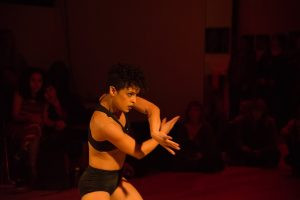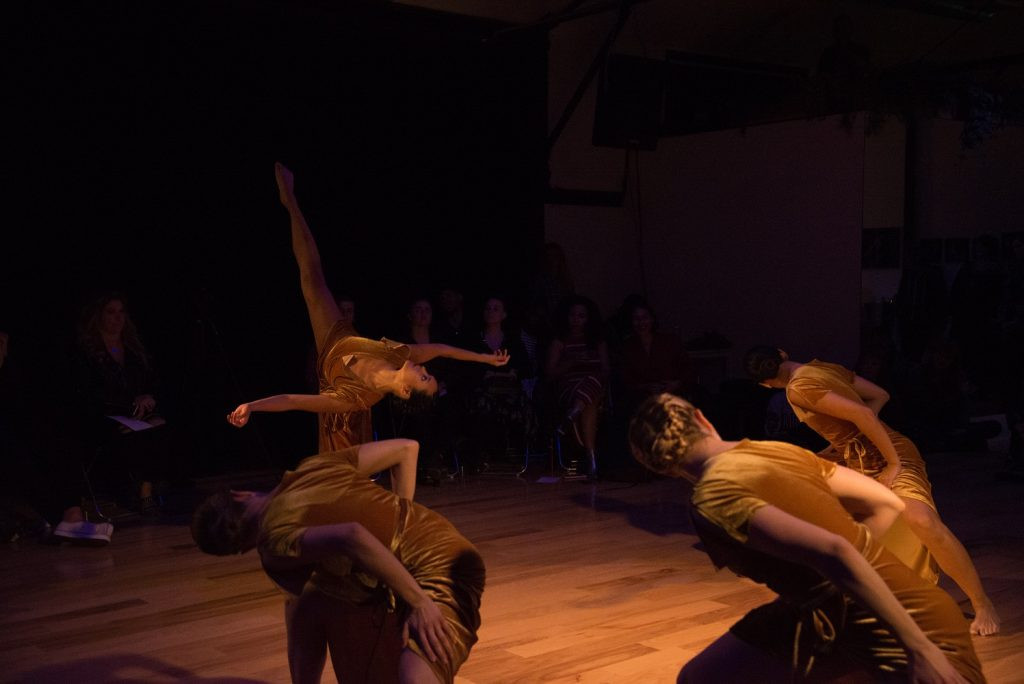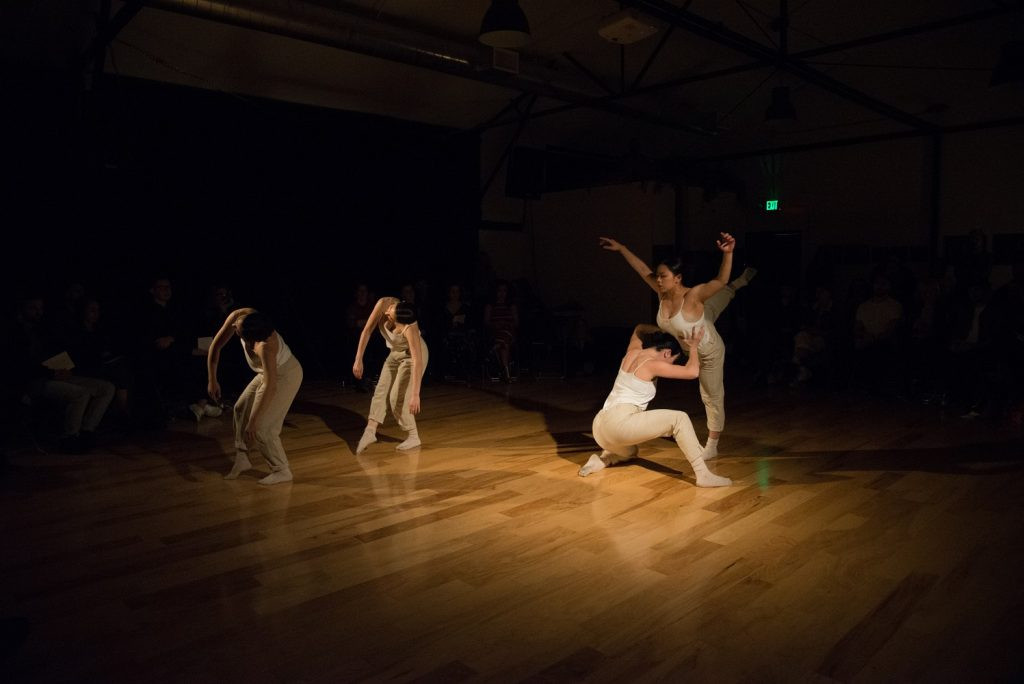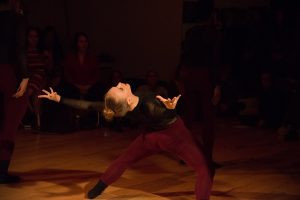MashUp Contemporary Dance Company marked International Women’s Day with a vibrant and dynamic day-long dance festival, Press for Progress, a powerful ode to the “strong, creative, and passionate females” within their community. The event, held on Thursday, March 8th, commenced with a series of invigorating free classes, culminating in an evening showcase at the company’s Frogtown headquarters. This studio-turned-performance space, nestled alongside the LA river, offered an intimate setting with audience members comfortably seated on chairs, couches, and benches. The pre-show atmosphere was further enhanced by footage of company dancers projected onto the exterior walls, creating an immediate connection to the artistry about to unfold.

A captivating moment from MashUp Contemporary Dance Company’s “Press for Progress” event, showcasing the energy of contemporary dance. Photo by Kelly Mustapha-Kellett.
As anticipation built during the approach to the studio in Elysian Park, a critical perspective began to form alongside the excitement for the evening. The notion of a performance being inherently feminist simply by virtue of being “all female” sparked a necessary skepticism. Throughout the showcase, this tension between impressed admiration for the dancers’ technical prowess and a questioning of the presented feminist message became central. The evening revealed a compelling, albeit sometimes uneven, blend of high-caliber contemporary dance technique and a form of early 2000s-esque “artivism,” prompting post-show reflections and note-taking.
The festival presented thirteen distinct performances – twelve dance pieces and a captivating live musical interlude by singer/songwriter Kiah Victoria. This diverse program encompassed a range of styles, both narrative and abstract, yet shared a cohesive commercial aesthetic and a streamlined approach to movement inherent in much of contemporary dance today.
One standout piece, “Wo(man)der,” choreographed by Nicole Hagen and brought to life by Lexi DiFilippo, Aika Doone, Vickie Roan, and Eugenia Rodriguez, was profoundly grounded and simply breathtaking. The choreography featured fluid attitude turns and a mesmerizing ronde de jambe en l’air sequence, distinguished by a beautifully staggered synchronicity. This intricate timing, as one astute observer noted, mirrored “the physical representation of singing a round,” highlighting the collaborative and harmonious aspects often explored in contemporary dance.
In contrast, “Aged,” performed by Cierra Crowley, Megumi Iwama, Joan Holly Padeo, Samantha Rose, and Claire Upton, explored abstraction through symmetry and structural repetition. The dancers functioned as a unified entity, punctuated by impactful breakout solos. Andrea Ordaz’s choreography for this piece was marked by sharp, defined movements and impressive side extensions, coupled with a dynamic breath-body connection. This parallelism seemed to delve into both individual physicality and collective embodiment, core themes often examined within contemporary dance. Building upon this sense of collectivity, “Ex-Factor,” a group piece choreographed by Tawnya Kuzia/MashUp, culminated in a powerful image of unity. The five dancers (Emily Andrews, Nicole Hagen, Stephanie Heckert, Leah LaGrange, and Abigail Ruz) coalesced into a circle, sinking to the floor while embracing each other in a gesture of hope and mutual support, a poignant representation of connection through movement in contemporary dance.

Dancers in MashUp Contemporary Dance Company’s “Press for Progress” showcase, exemplifying the collaborative nature of contemporary dance. Photo by Kelly Mustapha-Kellett.
“Growth,” choreographed by Renee Baldwin, and “Whoa It’s Me,” choreographed by Victoria Brown/MashUp, while distinct in their musical landscapes, emerged as quintessential examples of MashUp’s signature style. This style is characterized by kaleidoscopic choreography, fractal formations, and Horton technique influences, albeit with a distinctly funkier, more contemporary edge in their flat backs and overall movement quality. Both pieces featured dancers navigating space with controlled floor work and striking leg lifts, creating a symbiotic movement dialogue that facilitated complex and engaging partnering. These elements are hallmarks of dynamic contemporary dance vocabulary.
Matching the technical brilliance and exceeding the sheer charisma of the group performances, Nateli Ruiz’s solo “Enough,” choreographed by Monio Ashibi, was a true highlight. The piece commenced with a humorous skit set to an internal monologue detailing a comically disastrous date night. Ruiz then exploded into a sassy and technically demanding sequence of battements, body rolls, and backbends, all flawlessly synchronized to SZA’s Drew Barrymore. This fusion of narrative and virtuosic movement is a compelling aspect of contemporary solo dance. “Brainwasher,” choreographed by Sarah Rodenhouse/MashUp, commanded the stage with expansive grand pliés and intense, direct eye contact, while “Fever Pitch,” choreographed by Cat Cogliandro, injected an element of experimental theater through animated facial expressions. Both pieces effectively shifted the show’s tempo and expanded beyond its largely uniform commercial feel, showcasing the breadth possible within contemporary dance.

MashUp Contemporary Dance Company dancers in performance, demonstrating the technical skill and artistry of contemporary dance. Photo by Kelly Mustapha-Kellett.
The dancers, collectively, were undeniably phenomenal. Their impeccable synchronicity, captivating audience engagement, and breathtaking leg extensions were consistently impressive. However, reflecting on MashUp’s vision of a pro-feminist dance environment necessitates a deeper consideration of the core tenets of International Women’s Day and how the company’s aesthetic choices and thematic frameworks reflect broader societal understandings of womanhood, both historically and in contemporary contexts. This critical lens is crucial when examining contemporary dance events claiming feminist ideals.

A reflective moment during MashUp Contemporary Dance Company’s “Press for Progress,” inviting consideration of feminist themes in contemporary dance. Photo by Kelly Mustapha-Kellett.
The origins of International Women’s Day are rooted in labor activism. In 1857, garment workers in New York City initiated a strike protesting exploitative working conditions within factories. Their demands for fair wages and reduced working hours laid the groundwork for the first women’s labor unions. In 1910, at the Conference of Working Women in Copenhagen, Clara Zetkin proposed the establishment of an International Working Women’s Day. This motion, unanimously passed by over 100 women representing unions, socialist parties, and women’s working groups from 17 countries, led to the creation of what is now globally recognized as International Women’s Day. This historical context is often overlooked in contemporary celebrations.
In contemporary American culture, Women’s Day has, to a significant extent, been detached from these foundational Marxist-feminist principles. It frequently succumbs to corporate performativity – exemplified by companies like McDonalds inverting their arches to form a “W” while simultaneously engaging in practices that undermine women’s economic stability. Furthermore, certain diluted interpretations of Women’s Day celebrations can inadvertently reinforce exclusionary norms, particularly through a rigid emphasis on the gender binary and the marginalization of trans women. This is a crucial point to consider when examining any contemporary dance event themed around women’s empowerment.

The power and grace of contemporary dance at MashUp’s “Press for Progress,” prompting questions about representation and inclusivity within feminist celebrations. Photo by Kelly Mustapha-Kellett.
While MashUp’s technical execution was undeniably impressive, their artistic direction offered limited engagement with these crucial economic histories or relevant queer theory within their Women’s Day celebration. “Unravel Me,” a tender duet, visually prioritized cis-heteronormative relationships, while “Enough” reinforced this aurally. Titles and lyrical choices like “About Her” and “Wo(man)der” emphasized a somewhat monolithic concept of “universal womanhood.” Moreover, the consistent emphasis on coordinated, overtly feminine styling echoed outdated notions of gender as fixed and static. The company’s foundational premise – an “all female contemporary dance company… motivating young girls and women to be strong, confident, and articulate females” – raises questions about inclusivity and who is encompassed, and conversely excluded, within this vision of advocacy. MashUp occupies a perplexing middle ground. Despite the implied art-house aesthetic of a modest Frogtown studio, the company’s overarching style leaned heavily into tropes reminiscent of competition-style, Hollywood-influenced dance.
Ultimately, MashUp’s intentions appeared benevolent. Artistic Directors Victoria Brown and Sarah Rodenhouse explicitly emphasized “collaboration over competition” in their opening remarks, expressing gratitude to the dancers for their collective creation of the space. MashUp did not invent biological essentialism, nor are they unique in perpetuating such tropes within performance and visual art. Nevertheless, the experience prompted reflection. Driving back towards Echo Park, the central question lingered: what does a celebration of “female” truly mean for trans and non-binary individuals who are, perhaps unintentionally, excluded from such ostensibly patriarchy-smashing events? This is a vital conversation to continue within the contemporary dance world and beyond.
Featured photo by Kelly Mustapha-Kellett.
To view the LA Dance Chronicle Calendar of Performances, click here.

